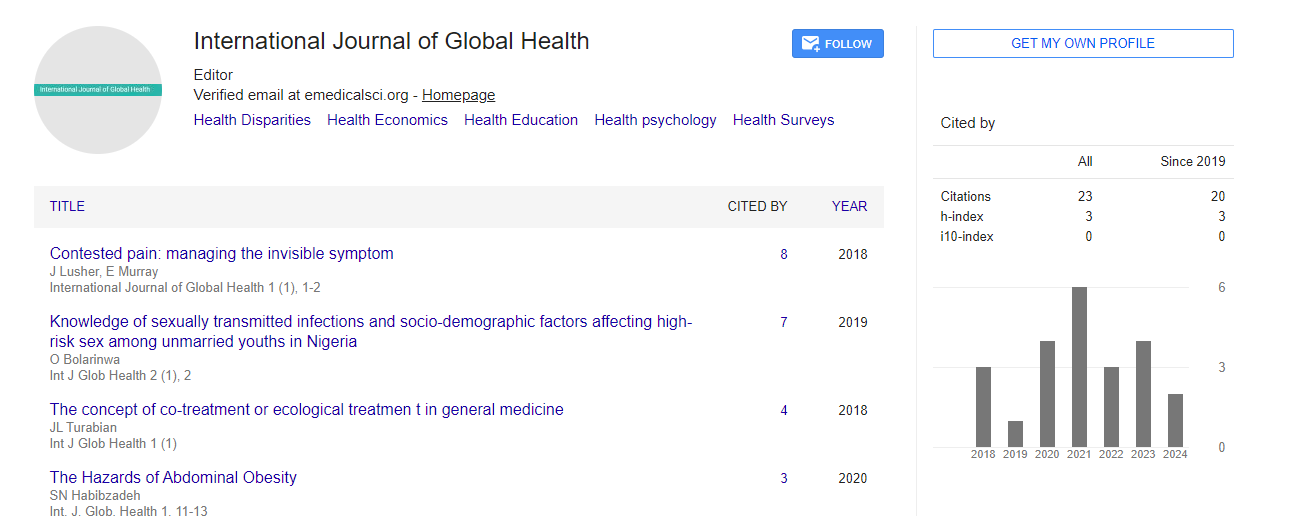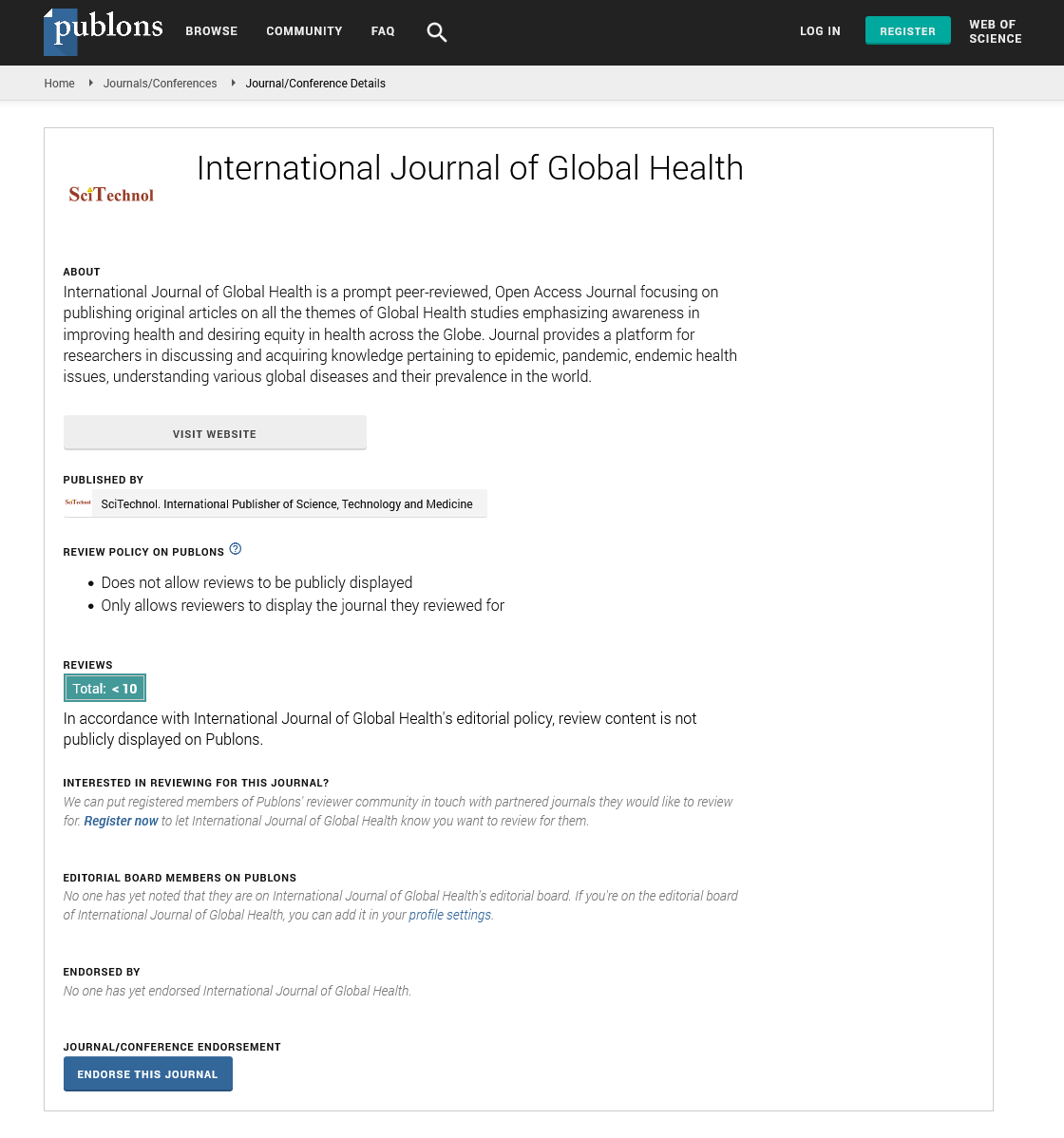Opinion Article, Int J Glob Health Vol: 6 Issue: 4
Digital Health Technologies in Low-Resource Settings: Opportunities and Limitations
Huang Moey*
1Department of Global Health Policy, Unity University, Harmonyville, USA
*Corresponding Author: Huang Moey,
Department of Global Health Policy, Unity
University, Harmonyville, USA
E-mail: Moeyhuang564@gmail.com
Received date: 27 November, 2023, Manuscript No. IJGH-24-125945;
Editor assigned date: 29 November, 2023, Pre QC No. IJGH-24-125945 (PQ);
Reviewed date: 14 December, 2023, QC No. IJGH-24-125945;
Revised date: 21 December, 2023, Manuscript No. IJGH-24-125945 (R);
Published date: 28 December, 2023, DOI: 10.4172/Ijgh.1000194
Citation: Moey H (2023) Digital Health Technologies in Low-Resource Settings: Opportunities and Limitations. Int J Glob Health 6:4.
Description
The integration of digital health technologies in low-resource settings holds immense potential to address healthcare challenges, enhance service delivery, and improve health outcomes. However, the adoption of these technologies also faces unique limitations that must be navigated to ensure their effective and sustainable implementation. Digital health technologies enable remote monitoring of patients, especially those with chronic conditions. Wearable devices, mobile apps, and telehealth platforms facilitate real-time data collection, allowing healthcare providers to monitor vital signs, adherence to treatment plans, and disease progression. This is particularly beneficial in low-resource settings where access to healthcare facilities may be limited.
Telemedicine platforms bridge the gap between healthcare providers and patients in remote areas. Virtual consultations allow individuals to access medical advice and consultations without the need to travel long distances. This can significantly improve healthcare access in regions with sparse healthcare infrastructure. Digital health systems facilitate the creation and maintenance of electronic health records. These systems streamline data management, reduce paperwork, and enhance the efficiency of healthcare delivery. Access to centralized health information enables better coordination of care, particularly in low-resource settings where paper-based records may be challenging to manage.
Mobile health interventions leverage the widespread use of mobile phones to deliver health-related information, reminders, and interventions. SMS-based educational programs, appointment reminders, and medication adherence support contribute to health promotion and disease management in areas with limited access to traditional healthcare services. Digital technologies facilitate health surveillance and data analytics, allowing for early detection of disease outbreaks and monitoring of public health trends. In low-resource settings, timely data analysis can inform targeted interventions and resource allocation to address emerging health threats.
Low-resource settings often lack the necessary infrastructure to support widespread digital health adoption. Insufficient internet connectivity, unreliable power sources, and limited access to electronic devices pose significant challenges. Implementing digital health solutions requires addressing these infrastructure gaps to ensure their feasibility. Digital health technologies assume a level of digital literacy that may be lacking in certain populations. Moreover, disparities in access to smartphones and other devices may exacerbate existing health inequalities. Ensuring equitable access and providing education on technology use are critical considerations in lowresource settings.
The lack of interoperability and standardization in digital health systems can hinder their effectiveness. In low-resource settings where diverse technologies may be in use, ensuring seamless integration and data exchange between different platforms becomes essential for cohesive and coordinated healthcare delivery. Digital health technologies involve the collection and storage of sensitive health information. Inadequate data security measures and concerns about privacy breaches can undermine trust in these systems. Robust data protection policies and cybersecurity measures are crucial to address these concerns.
The sustainability of digital health interventions in low-resource settings depends on ongoing maintenance and support. Without proper infrastructure for maintenance and updates, technologies may become obsolete or dysfunctional over time. Long-term planning and investment in technical support are vital for sustained success. Successful implementation of digital health technologies requires community engagement and consideration of cultural norms. Understanding local contexts, beliefs, and preferences ensures that technologies are culturally sensitive and accepted by the communities they serve.
Conclusion
Digital health technologies offer unprecedented opportunities to transform healthcare delivery in low-resource settings. However, realizing these benefits requires a thoughtful approach that addresses the unique challenges associated with limited resources, infrastructure, and accessibility. Collaborative efforts involving healthcare providers, technology developers, policymakers, and local communities are essential to harness the full potential of digital health in improving health outcomes and advancing healthcare equity worldwide.
 Spanish
Spanish  Chinese
Chinese  Russian
Russian  German
German  French
French  Japanese
Japanese  Portuguese
Portuguese  Hindi
Hindi 
